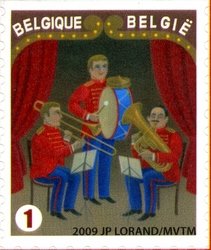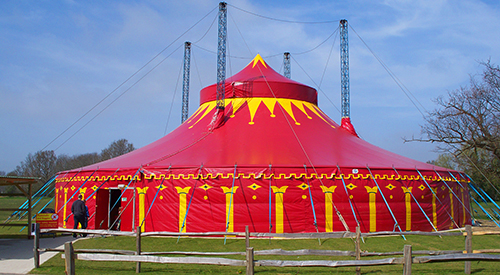Stamp: To the Circus - Orchestra (Belgium 2009)
To the Circus - Orchestra (Belgium 2009)
31 August (Belgium ) within release Leisure goes into circulation Stamp To the Circus - Orchestra face value 1 No Face Value
| Stamp To the Circus - Orchestra in catalogues | |
|---|---|
| Michel: | Mi:BE 3975 |
| Belgium: | Bel:BE 3929 |
| WADP Numbering System - WNS: | WAD:BE063.09 |
Stamp is vertical format.
Also in the issue Leisure:
- Stamp - Clown face value 1;
- Stamp - To the Circus - Orchestra face value 1;
- Stamp - Tightrope Walkers face value 1;
- Stamp - Conjurers face value 1;
- Stamp - Human Pyramid face value 1;
- Stamp - Acrobats face value 1;
- Stamp - Clown face value 1;
- Stamp - Acrobats face value 1;
- Stamp - Conjurer face value 1;
- Stamp - Acrobat on Horseback-Juggler face value 1;
|
Data entry completed
80%
|
|
|---|---|
| Stamp To the Circus - Orchestra in digits | |
| Country: | Belgium |
| Date: | 2009-08-31 |
| Size: | 25 x 30 |
| Perforation: | 10 |
| Format: | Stamp |
| Face Value: | 1 No Face Value |
Stamp To the Circus - Orchestra it reflects the thematic directions:
Music is an art form and cultural activity whose medium is sound organized in time. The common elements of music are pitch (which governs melody and harmony), rhythm (and its associated concepts tempo, meter, and articulation), dynamics (loudness and softness), and the sonic qualities of timbre and texture (which are sometimes termed the "color" of a musical sound). Different styles or types of music may emphasize, de-emphasize or omit some of these elements. Music is performed with a vast range of instruments and vocal techniques ranging from singing to rapping; there are solely instrumental pieces, solely vocal pieces (such as songs without instrumental accompaniment) and pieces that combine singing and instruments. The word derives from Greek μουσική (mousike; "art of the Muses"). In its most general form, the activities describing music as an art form or cultural activity include the creation of works of music (songs, tunes, symphonies, and so on), the criticism of music, the study of the history of music, and the aesthetic examination of music. Ancient Greek and Indian philosophers defined music as tones ordered horizontally as melodies and vertically as harmonies. Common sayings such as "the harmony of the spheres" and "it is music to my ears" point to the notion that music is often ordered and pleasant to listen to.
A musical instrument is a device created or adapted to make musical sounds. In principle, any object that produces sound can be considered a musical instrument—it is through purpose that the object becomes a musical instrument. A person who plays a musical instrument is known as an instrumentalist. The history of musical instruments dates to the beginnings of human culture. Early musical instruments may have been used for rituals, such as a horn to signal success on the hunt, or a drum in a religious ceremony. Cultures eventually developed composition and performance of melodies for entertainment. Musical instruments evolved in step with changing applications and technologies.
A circus is a company of performers who put on diverse entertainment shows that may include clowns, acrobats, trained animals, trapeze acts, musicians, dancers, hoopers, tightrope walkers, jugglers, magicians, ventriloquists, and unicyclists as well as other object manipulation and stunt-oriented artists. The term circus also describes the field of performance, training and community which has followed various formats through its 250-year modern history. Although not the inventor of the medium, Newcastle-under-Lyme born Philip Astley is credited as the father of the modern circus.


